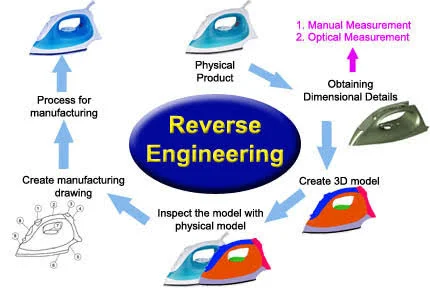Reverse engineering is the process of analyzing a product, system, or technology in order to understand its design, functionality, or components. This is typically done by disassembling, examining, and sometimes reconstructing the object to gain insight into how it works. Reverse engineering can be used for various purposes, such as understanding competitors' products, creating interoperable systems, identifying vulnerabilities, or gaining knowledge about proprietary technologies. It's a common practice in industries like software development, electronics, and engineering.
How reverse engineering works.
Reverse engineering typically involves the following steps:
1. **Analysis**: The object or system to be reverse-engineered is thoroughly examined, whether it's a physical product, software program, or electronic device.
2. **Decomposition**: The object is broken down into its individual components or code segments to understand its structure and organization.
3. **Observation**: Researchers or engineers closely observe how these components interact, communicate, and function together.
4. **Documentation**: Detailed notes, diagrams, and documentation are created to capture the discovered information and relationships.
5. **Reconstruction**: In some cases, a replica or functional model is built based on the reverse-engineered insights to understand the working principles.
6. **Analysis of Code**: In software reverse engineering, the code of a program is analyzed to understand its logic and algorithms. Tools like disassemblers and decompilers can help translate compiled code back into a human-readable form.
7. **Testing and Validation**: The reverse-engineered insights are tested to ensure they accurately reflect the original system's behavior.
8. **Iterative Process**: Reverse engineering often involves repeated cycles of analysis, observation, and documentation to refine the understanding of the object.
Keep in mind that reverse engineering should be carried out ethically and legally, respecting intellectual property rights and relevant laws.
Benefits of reverse engineering.
Reverse engineering offers several benefits across various industries:
1. **Understanding Technology**: It helps gain insights into complex technologies, enabling better understanding of how products or systems work.
2. **Interoperability**: Reverse engineering can aid in creating products that are compatible with existing systems or software, enhancing interoperability.
3. **Innovation**: By studying and dissecting existing products, engineers can identify opportunities for improvement and innovation.
4. **Cost Savings**: Reverse engineering can lead to cost-effective solutions by avoiding the need to develop systems from scratch.
5. **Legacy Systems**: It allows for the maintenance and modification of older systems that lack proper documentation or support.
6. **Security Analysis**: Reverse engineering helps identify vulnerabilities in software or hardware, contributing to enhanced cybersecurity.
7. **Competitive Analysis**: It provides insights into competitors' products, allowing companies to analyze strengths and weaknesses.
8. **Repair and Reproduction**: Reverse engineering assists in repairing and reproducing obsolete or hard-to-find parts.
9. **Educational Tool**: It serves as a valuable learning tool for students, helping them understand real-world applications of theoretical concepts.
10. **Customization**: Reverse engineering enables customization of products to meet specific requirements.
11. **Legal and Compliance Issues**: It can assist in investigating patent infringement or ensuring compliance with industry standards.
12. **Archiving and Documentation**: Reverse engineering helps preserve knowledge about systems that lack proper documentation.
Despite these benefits, it's important to note that ethical considerations and legal constraints must be followed when engaging in reverse engineering activities, especially to respect intellectual property rights and contractual agreements.

